Home » Blog » Dissertation » Topics » Architecture » Interior Design » 80 Interior Design Research Topics


80 Interior Design Research Topics
FacebookXEmailWhatsAppRedditPinterestLinkedInAre you a student eager to explore captivating research avenues in Interior design? Look no further, for you’re in the right spot. Our comprehensive collection of research topics in Interior Design is here to ignite your curiosity and guide you on a rewarding journey. Whether you’re pursuing an undergraduate, master’s, or doctoral degree, these thought-provoking […]

Are you a student eager to explore captivating research avenues in Interior design? Look no further, for you’re in the right spot. Our comprehensive collection of research topics in Interior Design is here to ignite your curiosity and guide you on a rewarding journey.
Whether you’re pursuing an undergraduate, master’s, or doctoral degree, these thought-provoking topics will inspire your thesis or dissertation and contribute to the dynamic realm of interior design. From innovative sustainable practices to human-centric design solutions, we’ve got you covered with diverse possibilities to enrich your academic exploration and shape the future of interior design.
A List Of Potential Research Topics In Interior Design
- Repurposing shipping containers: innovative design approaches for affordable housing.
- Resilient interior spaces: adapting homes and commercial interiors for future crises and disturbances.
- Urban farming integration in residential interior design: sustainable living.
- Revitalizing public spaces: community participation in urban interior design.
- Technological innovations in interior design: a literature review on integrating technology and intelligent solutions in interior spaces.
- Aesthetics and functionality in kitchen design: user-centred approach.
- Community-centric library design: creating inclusive and dynamic civic spaces.
- Retail store design and consumer behaviour : a study of visual merchandising techniques.
- Workplace flexibility and design: navigating remote work trends.
- The role of interior design in enhancing student learning outcomes.
- Biodegradable materials in interior design: exploring the potential for sustainable innovation.
- The impact of virtual reality technology on interior design visualization.
- Digital integration in workspace design: exploring technology integration and human-centric design principles in UK office interiors.
- Smart homes and IoT-driven interior design: evaluating the role of Internet of things (IoT) in shaping contemporary residential spaces.
- Zero-carbon homes and sustainable interior design: assessing strategies for achieving net-zero emission standards in residential spaces.
- Reimagining retail: interactive and experience-driven store environments.
- Interactive exhibition spaces: engaging visitors through immersive design.
- Ageing-friendly bathroom design: ensuring safety and comfort for elderly users.
- Historical evolution of interior design styles: tracing the development of design movements and their impact on contemporary interiors.
- Health-conscious workplace design: exploring strategies to create safe and healthy work environments in the post-pandemic era.
- Spatial configuration and human behaviour: analyzing research on how interior layouts influence user behaviour and interaction.
- Minimalism in interior design: aesthetics, functionality, and user experience.
- Reviving tradition: a modern interpretation of historic interior spaces.
- The influence of biophilic design on indoor air quality and wellbeing.
- Adaptive retail design: navigating changing consumer behaviour and expectations in the retail landscape.
- Cultural heritage preservation through adaptive reuse: reviving historic buildings.
- Colour psychology in interior design: analyzing existing literature to understand the psychological impact of colours on human emotions.
- Urban green spaces: design strategies for intimate and sustainable outdoor environments.
- Resilient design for disaster-prone areas: minimizing risk and enhancing safety.
- The psychology of waiting rooms: design strategies for patient wellbeing.
- Human-centred lighting design for elderly care facilities.
- Universal design principles in interiors: reviewing the application of inclusive design for diverse user groups and needs.
- Multi-generational living spaces: designing for harmonious coexistence.
- Adaptive interior design for healthcare facilities: flexibility and patient needs.
- Designing for ageing in place: adaptable interiors for long-term residences.
- Interior design for mental health facilities: creating therapeutic environments.
- Sustainable material selection in interior design: balancing aesthetics and eco-friendliness.
- Virtual collaboration in interior design: challenges and opportunities.
- Modern healthcare interiors: integration of technology and patient-centric design.
- Interior design for cultural institutions: showcasing heritage and art.
- Biophilic design in interior spaces: a comprehensive review of research on integrating nature and wellbeing in interior design.
- Socially inclusive public spaces: redefining urban design to foster community engagement and physical distancing.
- Playful learning environments: interior design for children’s education centres.
- Luxury residential interior design: opulence, exclusivity, and lifestyle expression.
- Spatial layout and acoustic design in educational environments.
- Hybrid learning environments: designing flexible and technology-integrated educational spaces for blended learning.
- The role of textiles in interior design: innovations and sustainability.
- Interior design for ageing retail shoppers: accessibility and user-centric layouts.
- Sustainable home offices: integrating eco-friendly design principles into remote workspaces.
- Transformative interior design: adaptive environments for people with disabilities.
- Airport terminal design and passenger experience: enhancing comfort and efficiency.
- Smart homes and interior design: integration of IoT and automation.
- We are enhancing workplace productivity through ergonomic office design.
- Wellness retreats: designing interior environments for mental and physical restoration.
- British cultural identity in interior design: examining how cultural references shape design aesthetics in UK homes.
- Virtual reality in interior design: examining the role of VR in enhancing design collaboration and visualization.
- Home wellness retreats: creating tranquil and rejuvenating residential interiors for mental and physical wellbeing.
- Residential multi-functional spaces: designing versatile and efficient homes for remote work, leisure, and fitness.
- Residential feng shui: traditional principles in modern interior design.
- Sustainability and materials in interior design: a critical review of sustainable material choices and their applications in interior spaces.
- The role of colour psychology in healthcare interior design.
- Hospitality design resilience post-pandemic: redefining hotel interiors for guest safety, comfort, and experiences.
- Retail store atmospherics and consumer behaviour: reviewing studies on how interior design elements affect customer perceptions and purchases.
- Transformative adaptive reuse: a case study of UK industrial buildings transformed into innovative and functional interior spaces.
- Reconnecting with nature: biophilic design in urban apartments.
- Inclusive design for the ageing population: investigating interior design solutions to enhance accessibility and comfort for older people.
- Sustainable kitchen design: minimizing food waste and energy consumption.
- Interior design for e-commerce warehouses: efficiency and aesthetics.
- Art integration in interior design: fostering creativity and cultural engagement.
- Waterfront development and interior design: creating vibrant coastal spaces.
- Public transportation interiors: enhancing comfort and efficiency.
- Retail pop-up stores: innovative design and temporary brand experiences.
- Inclusive design in hospitality interiors: creating accessible and welcoming spaces.
- Sustainable hotel design: strategies for eco-friendly hospitality interiors.
- Adaptive reuse of industrial spaces: transforming factories into contemporary living spaces.
- We are revitalizing urban retail design: enhancing high-street shopping experiences through innovative interior concepts.
- Eco-conscious hospitality interiors: innovations in sustainable design for hotels and accommodation.
- Home office design for remote work: comfort, productivity, and creativity.
- Cultural identity and interior design: exploring authentic expression in globalized spaces.
Exploring these Interior Design research topics across degrees leads to enriching insights. From colour psychology to sustainability integration, these subjects unveil the art and science of interior spaces. Whether pursuing undergraduate, master’s, or doctoral studies, these topics offer a profound understanding of Interior Design’s evolving landscape.
Order Interior Design Dissertation Now!
External Links:
- Download Interior Design Dissertation Sample For Your Perusal
Research Topic Help Service
Get unique research topics exactly as per your requirements. We will send you a mini proposal on the chosen topic which includes;
- Research Statement
- Research Questions
- Key Literature Highlights
- Proposed Methodology
- View a Sample of Service
Ensure Your Good Grades With Our Writing Help
- Talk to the assigned writer before payment
- Get topic if you don't have one
- Multiple draft submissions to have supervisor's feedback
- Free revisions
- Complete privacy
- Plagiarism Free work
- Guaranteed 2:1 (With help of your supervisor's feedback)
- 2 Installments plan
- Special discounts
Other Posts
- 80 Architecture Research Topics August 7, 2023 -->
- 80 Landscape Architecture Research Topics August 9, 2023 -->
- 80 Sustainable Architecture Research Topics August 8, 2023 -->
- 80 Urban Planning Research Topics August 8, 2023 -->
WhatsApp us

- iSpartan Email iSpartan Email
- UNCGenie UNCGenie
- UNCG Directory UNCG Directory
- Canvas Canvas
- Inside UNCG
- Administration
- Arts & Entertainment
- Equity, Diversity & Inclusion
- Giving to UNCG
- International Programs
- Online Courses & Degrees
- Student Affairs
- University News
Interior Architecture
- Undergraduate
- Historic Preservation
- Academic Advising FAQ
- Diversity, Equity and Inclusion
- News & Events
- Graduate Home
- Graduate Resources
- MFA Alumni Stories
- Scholarships

Past Thesis Titles
All M.F.A. students in Interior Architecture complete theses. Theses cover a wide range of topics within interior architecture and reflect the variety of student research interests. The thesis topic is developed by the student in concert with her/ his faculty in the first year of study. The following theses have been completed by graduate students since 1990. All IAR theses since 2005 are available online through the UNCG Library .
The Department of Interior Architecture UNC Greensboro
Physical Address: 102 Gatewood Studio Arts Building Greensboro, NC 27412
Mailing Address: P.O. Box 26170 Greensboro, NC 27402
Phone: 336.334.5320

Copyright © 2024. UNC Greensboro. All rights reserved. | If you have a disability and are having trouble accessing information on this website or need materials in an alternate format contact [email protected] for assistance.
- Technical Support
- Find My Rep
You are here
Journal of Interior Design
Preview this book.
- Description
- Aims and Scope
- Editorial Board
- Abstracting / Indexing
- Submission Guidelines
The Journal of Interior Design is a scholarly, refereed publication dedicated to a pluralistic exploration of the interior environment. The Journal seeks to move the discipline forward by welcoming scholarly inquiry from diverse and interdisciplinary approaches, perspectives, and methods that actively explore and analyze the evolving definition of the interior. The Journal’s publications investigate the interior relative to design, human perception, behavior, and experience, at all scales and for all conditions. Scholarship published in the Journal shapes, informs, and defines interior design education, practice, research, criticism, and theory. (Revised February 2021)
The Journal of Interior Design is a scholarly, refereed publication dedicated to a pluralistic exploration of the interior environment. The Journal seeks to move the discipline forward by welcoming scholarly inquiry from diverse and interdisciplinary approaches, perspectives, and methods that actively explore and analyze the evolving definition of the interior. The Journal’s publications investigate the interior relative to design, human perception, behavior, and experience, at all scales and for all conditions. Scholarship published in the Journal shapes, informs, and defines interior design education, practice, research, criticism, and theory. (Revised February 2021)
- Clarivate Analytics: Arts & Humanities Citation Index (AHCI)
Manuscripts for consideration should be submitted online at https://mc.manuscriptcentral.com/interiordesign .
SUBMISSION TYPES Scholarly inquiry appropriate for submission to the Journal of Interior Design falls into four distinct categories:
Invited Perspectives: A position on current issues that impact interior design. Typically an invitation sent by Editor.
Invited Perspectives provide a forum for the exchange and debate of ideas among educators, practitioners, and other interested parties. Perspectives are not double-anonymously reviewed. They are evaluated solely by the editor-in-chief. The purpose of Invited Perspectives is to inspire discussion of critical issues facing interior design practice and education. Examples of Invited Perspectives considered for publication include, but are not limited to:
- Discussion of current topics and concerns
- Expression of a particular position or stance
Letters: Responses to ideas published in JID or presented at design conferences.
Letters offer the opportunity to engage in stimulating dialogue for the purpose of advancing the discipline. While letters expressing a personal opinion are encouraged, such opinions must be supported and substantiated by facts, evidence from the literature, and/or experts in the field. Letters should be submitted in essay format and the issue, position, or article/presentation being addressed must be clearly identified. Letters considered for publication include, but are not limited to:
- Response to invited perspectives shared in previous JID issues
- Response to an idea or concept presented in an article or at design conferences
Articles: Theoretical, Empirical, Historical and/or Critical Inquiries
Articles must be inquiries made in the context of a theoretical or conceptual framework, with analysis based on an identified set of criteria. Articles should educate the reader about a particular work, artist, object, or theory in relation to an area of expertise, a broader context, and/or as a solution to satisfy human social, physical, and psychological needs. A theoretical/conceptual framework from any discipline can be used to develop criteria so long as it is shown to have a meaningful relationship with the work to be analyzed. Papers in this submission category should increase the knowledge base and reinforce the value of discourse in design studies. Content should focus on interior design issues of scholarly content that will contribute to the body of knowledge. Examples of articles considered for publication include, but are not limited to:
- Exploration of an issue or formulation of a position
- Criticism of designed environments
- Design history and/or historic preservation
- Socio/Cultural aspects of interior environments
- Design teaching and pedagogy
- Design philosophy
- Design theory and theory development
- Behavioral relationships and interior environments
- Human factors and interior environments
- Material culture and interior environments
Visual Essays Articles presenting creative scholarship take the form of visual essays which are known to communicate ideas using an image-word relationship. While presenting practice-based research including speculative design, and maintaining a level of criticality, creative scholarship articles are led by the design object, event, process, system, artifact, space, or interior. The design is the subject of inquiry and the most prominent aspect. In this case, the article includes a contextual statement that introduces the design, the research topic, and the perspective. Rather than rely on the authority of textual language, the article develops as a series of pages where text and/or images are situated as interdependent elements. Here images, photographs, drawings, sketches and diagrams and textual language of all kinds play a pivotal role in shaping an intellectual inquiry. Authors should shape the visual essay to best communicate the design and inquiry. Please refer to the JID Creative Scholarship issue (vol. 43, no. 1) for examples of how authors have formatted the visual essay as well as dealt with the text : image relationship. These are just examples; authors are encouraged to explore other options that keep within the parameters noted under Submission Guidelines for Visual Essays
SUBMISSION GUIDELINES Manuscripts for consideration should be submitted online at https://mc.manuscriptcentral.com/interiordesign . Full instructions and support are available on the site and a user ID and password can be obtained on the first visit. If you cannot submit online, please contact Kathleen Sullivan in the editorial office via email: [email protected] .
Submission Guidelines for Articles/Perspectives/Letters
Submission Guidelines for Visual Essays
ARTICLE PREPARATION SUPPORT Sage Author Services offers expert help with English Language Editing, as well as translation, manuscript formatting, figure illustration, figure formatting, and graphical abstract design – so you can submit your manuscript with confidence.
RESUBMISSIONS Attach copies of all Editorial recommendations related to the original submission. Note changes in manuscript title if appropriate and update any contact information that may have changed since the time of original submission. Re-submit online at https://mc.manuscriptcentral.com/interiordesign .
REVIEW PROCESS The Journal of Interior Design follows an anonymous review process. Each manuscript is reviewed by two reviewers and the Editor. The total turnaround period to complete the process of review and analysis varies between three to six months. The final recommendation is sent to the correspondence author by the Editor-in-Chief. Outcomes include: (a) publish as is, (b) minor revisions, (c) revise and resubmit for review, (d) reject.
SUBMISSION DEADLINES JID operates on a “rolling submission” policy. As such, there are no deadlines for submission; each submission is processed as soon as it is received. However, calls for special issues will have specific deadlines.
COMMITMENT TO SCHOLARLY INTEGRITY The Journal employs iThenticate Professional Plagiarism Prevention to better ensure the originality of published research and scholarship using the most comprehensive scholarly comparison database.
QUESTIONS Questions regarding manuscript preparation and submission should be addressed to Kathleen Sullivan, Editorial Assistant, at [email protected] .
AUTHOR LICENSING If a paper is accepted for publication, the author identified as the formal corresponding author will be required to complete a copyright license agreement on behalf of all authors of the paper.
General information regarding licensing and copyright is available here .
Self-Archiving Definitions and Policies: Note that the journal’s standard copyright agreement allows for self-archiving of different versions of the article under specific conditions. Please click here for more detailed information about self-archiving definitions and policies.
Open Access fees : Authors who choose to publish using Open Access will be charged a fee. More information can be found here .
Open Access Agreements : Please click here for more information on Sage’s current Open Access agreements.
PUBLICATION PROCESS AFTER ACCEPTANCE
Proofs Your Sage Production Editor will keep you informed as to your article’s progress throughout the production process. Proofs will be made available to the corresponding author via our editing portal Sage Edit or by email, and corrections should be made directly or notified to us promptly. Authors are reminded to check their proofs carefully to confirm that all author information, including names, affiliations, sequence and contact details are correct, and that Funding and Conflict of Interest statements, if any, are accurate.
- Read Online
- Sample Issues
- Current Issue
- Email Alert
- Permissions
- Foreign rights
- Reprints and sponsorship
- Advertising
Individual Subscription, E-access
Individual Subscription, Combined (Print & E-access)
Institutional Subscription, E-access
Institutional Subscription & Backfile Lease, E-access Plus Backfile (All Online Content)
Institutional Subscription, Print Only
Institutional Subscription, Combined (Print & E-access)
Institutional Subscription & Backfile Lease, Combined Plus Backfile (Current Volume Print & All Online Content)
Institutional Backfile Purchase, E-access (Content through 1998)
Individual, Single Print Issue
Institutional, Single Print Issue
To order single issues of this journal, please contact SAGE Customer Services at 1-800-818-7243 / 1-805-583-9774 with details of the volume and issue you would like to purchase.
- Become an Interior Design Educator
- Job Searching Listings
- Become a Member
Publications

- Journal of Interior Design
- IDEC Exchange
- Conference Proceedings
- Member Published Books
Conferences & Events
- IDEC Conferences
- Regional Conferences
- Symposia + Workshops
- Submission Rubrics
- Competitions & Grants

- IDEC Competitions
- IDEC Grants
- Open Calls & Opportunities

- Become Member
- Publications Overview
- Regional Conference Proceedings
- Conference & Events Overview

- Competitions + Grants + Awards Overview
The Journal of Interior Design is an academic publication exploring various interior environment aspects. It welcomes diverse and interdisciplinary research to advance the field. The journal focuses on studying the interior of design, human perception, behavior, and experiences, covering all scales and conditions. The research published in the journal influences interior design education, practice, research, criticism, and theory.
Members of IDEC can access the journal as a membership benefit. Access requires logging in with IDEC membership information. You can also view the 2020 Publishers Report for the journal.
Gain insights into the latest discussions in the field of interior design by reading the latest issues of the Journal of Interior Design.
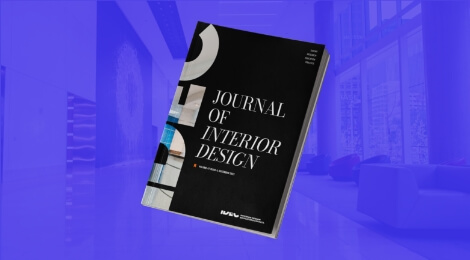
Journal of Interior Design (JID) FAQ
Quickly find answers to common question queries regarding The Journal of Interior Design through our Frequently Asked Questions section.
The Review Process
Have you ever wondered what happens to your essay or manuscript once it is submitted to the Journal of Interior Design (JID)? In this webinar, the editors and reviewers detail the review process for JID .
The webinar is divided into five parts:
- a detailed description of the review process by Joan Dickinson, Ph.D., Editor-in-Chief (EIC)
- factors considered when reading the initial submittal of the manuscript/essay by Lynn Chalmers, Ph.D., Associate Editor (AE), Joan Dickinson, Ph.D., EIC, and Nam-Kyu Park, Ph.D., AE
- the notice of revision (NOR): What is this? What does it look like? by Joan Dickinson, Ph.D., EIC
- how to respond to reviewer comments by Joan Dickinson, Ph.D., EIC
- reviewer perspectives and insights regarding the review process by Mary Anne Beecher, Ph.D., Anna Marshall-Baker, Ph.D., and Marilyn Read, Ph.D.
Specifically, the editors provide increased transparency of how the review process works for JID. The steps involved once the manuscript is received through Scholar One/Manuscript Central (the website used for manuscript submittal) are described. Additionally, insight from the review board provides an additional layer of guidance on what to expect once your manuscript or essay is reviewed and returned. The webinar is available for viewing at: https://youtu.be/wdHJTTwChpk .
The Journal will then host a live session on Thursday, April 7 from 3:00-4:30 PM EST , to enable dynamic discussion and answer questions related to the online webinar. The live session will give new authors, graduate students, and established authors the opportunity to meet the editorial staff along with the editorial review board to ask questions. The live session will address:
- Discussion and questions regarding the review process.
- Guidance for new authors, graduate students, and established authors submitting revised manuscripts or essays.
- Insight from reviewers and editors on factors considered when reading the initial submittal of a manuscript or essay.
The webinar is free to anyone interested in submitting an article to JID. Pre-registration is required for the access links.
Crafting a Successful Submission to JID
Providing strategies for crafting a successful submission
The webinar is divided into four distinct parts:
- introduction and JID Mission Statement (minute 00)
- visual essays moderated by Lynn Chalmers, Ph.D. (minute 2:50)
- articles from a humanities perspective discussed by Ronn Daniel, M. Arch (minute 22:08)
- social sciences approach by Joan Dickinson, Ph.D. (minute 44:27)
This webinar encourages a variety of research approaches, examines the rubrics used by external reviewers when evaluating an article or visual essay, and offers insight into how to prepare a submission that supports the author’s viewpoints along with suggestions for carefully developing interior-based content for positive review.
JID Board of Directors

Bryan Orthel
Indiana University Bloomington

Joan Dickinson
Editor-in-Chief Radford University

Lynn Chalmers
Associate Editor – Creative Scholarship University of Manitoba

Nam-Kyu Park
Associate Editor University of Florida

Amanda Gale
Director University of North Carolina, Greensboro

Alison Snyder
Director Pratt Institute

Lisa Tucker
Liaison to the Board of Directors Virginia Polytechnic Institute and State University
Log into your IDEC account to view the JID P&P in the Member Center .
New Virtual Issue
In the latest virtual issue, When You Can’t – Designing Supportive Housing for Refugees, Dr. Tasoulla Hadjiyanni asks readers to consider the following: “What does home mean to you? What defines your identity, and who would you be if you lost those elements that constitute your being? Then, take a look around your home and ask yourself: What would I take with me if I had to flee my house while bombs were falling all around me? And, how would I pick up the pieces to rebuild my life as a refugee?” Dr. Hadjiyanni, who sought refuge at a Meneou plantation during Turkey’s invasion of Cyprus, curates JID articles focused on vulnerability, dignity, and resilience that provide design recommendations related to supportive housing. As you read these papers, ask yourself: What kind of design interventions can you employ to transform housing into home for a population that hopes their relocation will be a temporary situation? And, how can design help heal the traumas of displacement, restoring dignity and a belief in the future?
JID Award Recipients
Jid best article.
PJ Carlino Ph.D. JID 46.1 Tied to the Desk: The Somatic Experience of Office Work, 1870–1920 (pages 27-43)
Giyoung Park Ph.D., Upali Nanda Ph.D., Lisa Adams, Jonathan Essary M.Arch., Melissa Hoelting B. Arch, HKS, USA JID 45.1 Creating and Testing a Sensory Well-Being Hub for Adolescents with Developmental Disabilities (pages 13-32)
Stephanie Liddicoat JID 44.2 Spirituality in Therapeutic Spaces: Perceptions of Spatiality, Trace, and Past Rituals Manifesting Present Occupation (pages 26-42)
Amy Huber JID 43.4 Exploring Hiring Practitioner Preferences for and Assessment Practice of Prospective Candidates (pages 21-44)
Xiaobo Quan, Anjali Joseph, & Upali Nanda JID 42.1 Developing Evidence-based Tools for Design and Evaluating Hospital Inpatient Rooms (pages 19-38)
Dianne Smith & Linda Lilly JID 41.2 Understanding Student Perceptions of Stress in Creativity-Based Higher Education Programs: A Case Study in Interior Architecture (pages 39-55)
JID Outstanding Reviewer of the Year
Jid resources & opportunities.

Call for JID Ad-Hoc Reviewer
The Board of Directors of the Journal of Interior Design (JID) invites applications for an Ad-Hoc Reviewer.

Special Issue Call for Papers
View submission deadlines and requirements for the Call for Papers for the Special Issue for the Journal of Interior Design (JID)
Theme: Leading by Design: Evolving Practices to Face the Challenges of our Times

Scholarly Publishing Resources
Andrew M. Ibrahim, MD, MSc1, Justin B. Dimick, MD, MPH2 1Department of Surgery, University of Michigan, Ann Arbor, MI, United States; 2Department of Surgery, Center for Healthcare Outcomes and Policy, University of Michigan, Ann Arbor, MI, United States

- IDEC History
- IDEC Board of Directors
- IDEC Annual Reports
- Governing Documents
- IDEC Regions
- IDEC Partners
- Conferences
Competitions + Grants
Opportunities.
- Member Center
Career Center
Competitions + grants + awards.
© 2024 Interior Design Educators Council
Privacy Policy Terms + Conditions Privacy Settings Refund Cancellation Policy
interior design Recently Published Documents
Total documents.
- Latest Documents
- Most Cited Documents
- Contributed Authors
- Related Sources
- Related Keywords
Aesthetic Evaluation of Interior Design Based on Visual Features
In the modern context, interior design has inevitably become a part of social culture. All kinds of modeling, decoration and furnishings in modern interior space show people's pursuit and desire for a better life. These different styles of modern interior design rely on science and technology, utilize culture and art as the connotation. Its development often reflects the cultural spirit of a nation. The aesthetic evaluation plays an important role in the modern interior design. With development of derivative digital devices, a large number of digital images have been emerged. The rapid development of computer vision and artificial intelligence makes aesthetic evaluation for interior design become automatic. This paper implements an intelligent aesthetic evaluation of interior design framework to help people choose the appropriate and effective interior design from collected images or mobile digital devices.
Effect of Variable Conditions of Exposure on the Physical and Mechanical Properties of Blockboards
The growing demand for wood and the continued increase of the raw material price have resulted in companies using more efficient wood resources in wood-based products such as blockboard. These boards are used in the field of interior design, especially. The aim of this research was to evaluate the effect of variable environmental conditions on the physical and mechanical properties of blockboard (BK). Two types of commercial BK were exposed in variable environmental conditions (kitchen, bathroom and climatic chamber) for three months. The BK structures were composed of veneer (V) and high-density fibreboards (HDF) for the face sheets and glued, solid wood, resinous strips for the core. The temperature and relative humidity of the air (RH) ranged from 18 °C to 25 °C and from 25% to 90%, respectively. In the climatic chamber (CC), the dynamics of the parameter variations were different than in the other two exposure climates, being determined by the programmed cyclic changes in RH. The changes observed on physical and mechanical properties were more extreme for the blockboards tested in the CC than in the kitchen (K) and bathroom (Ba). After 3 months of exposure in the CC, the thickness and weight of the boards increased by 1.8 and 1.1 times, respectively, for veneered BK, and by 4.4 and 0.4 times, for BK with HDF faces, compared to values recorded in the kitchen. The panels exposed in the CC exhibited the highest increase in moisture content (MC): 41% for veneered BK and 82% for BK with HDF faces after three months of exposure, followed by those exposed in the bathroom and kitchen. Increases in MC determined decreases of flexural properties and soundness surfaces, more evident for HDF face structures compared to V ones.
Natural Fibre Insulation Materials: Use of Textile and Agri-food Waste in a Circular Economy Perspective
AbstractFibrous materials are among those most used for the thermal and acoustic insulation of building envelopes and are also suitable for a wide range of applications. In building construction, the demand for products with low environmental impact — in line with the Green Deal challenge of the European Community — is growing, but the building market is still mostly oriented towards traditional products, missing the many opportunities for using waste materials from existing industrial production. The paper presents the experimental results of new thermal and acoustic insulation products for building construction and interior design, based on previous experiences of the research group. They are produced entirely using waste sheep’s wool as a “matrix” and other waste fibres as “fillers”. The materials proposed originate from textile and agri-industrial chains in the Piedmont region and have no uses other than waste-to-heat biomass. The panels have characteristics of rigidity, workability, and thermal conductivity that make them suitable for building envelope insulation.
The impact of independent campus learning program (MBKM) through matching fund program for lecturers, students and partners in Minggirsari Village, Blitar
One of the activities in the implementation of the Independent Campus Learning Program (MBKM) has been implemented through the Matching Fund program which was held in Minggirsari Village, Blitar. This activity has succeeded in establishing the Creative Economy and Tourism Research Center. The potential of Minggirsari village is divided into 17 sub-sectors based on creative economy sub sector, namely game development, architecture, interior design, music, fine arts, product design, fashion, culinary, film-animation-video, photography, visual communication design, TV-radio, crafts, advertising, performing arts, publishing and applications. The synergy between intellectuals, business, and government is the main actor driving the birth of creativity, ideas, science and technology that are vital for the growth of creative industries in Indonesia. Based on the existing potential, this activity provides the widest possible learning space to improve students' ability in creative thinking and critical thinking to enter the business world. In addition, this activity is also a forum for lecturers to develop research results on the creative economy. This activity also facilitates village residents to get provisions in developing their potential to help build Minggirsari village into a creative economy village. For this reason, this research is expected to be able to measure the impact resulting from learning activities that have been carried out through the matching fund program for lecturers, students and partners. This research uses a quantitative approach with a survey method. Data analysis in this study used descriptive data analysis methods.
Research on Optimization of Climate Responsive Indoor Space Design in Residential Buildings
This paper first analyzes the climate characteristics of five typical cities in China, including Harbin, Beijing, Shanghai, Shenzhen and Kunming. Then, based on Grasshopper, Ladybug and Honeybee analysis software, according to the indoor layout of typical residential buildings, this research extracts design parameters such as the depth and width of different rooms and their window-to-wall ratios etc., to establish a climate responsive optimization design process with indoor lighting environment comfort, with heating and cooling demand as the objective functions. Meanwhile, based on Monte Carlo simulation data, ANN (Artificial Neural Network) is used to establish a prediction model to analyze the sensitivity of interior design parameters under different typical cities’ climatic conditions. The study results show that the recommended values for the total width and total depth of indoor units under the climatic conditions of each city are both approximately 14.97 m and 7.88 m. Among them, under the climatic conditions of Harbin and Shenzhen, the design parameters of residential interiors can take the recommended value of UDI optimal or nZEB optimal. While the recommended values of window-to-wall ratios for the north bedroom, master bedroom and living room in Shanghai residential interiors are 0.26, 0.32 and 0.33, respectively. The recommended value of the window-to-wall ratio of the master bedroom in Kunming residences is 0.36, and that of the remaining rooms is between 0.15 and 0.18. The recommended values of window-to-wall ratios for the master bedroom and living room in Beijing residences are 0.41 and 0.59, respectively, and that for the remaining rooms are 0.15. The multi-objective optimization process based on parametric performance simulation used in the study can effectively assist architects in making energy-saving design decisions in the preliminary stage, allowing architects to have a case to follow in the actual design operation process.
A review of research in activity-based working over the last ten years: lessons for the post-COVID workplace
Purpose The purpose of this paper is to map and describe findings from research conducted in workspaces designed to support activity-based working (ABW) over the past 10 years (2010–2020) with a view of informing post-COVID workplaces of the positive and negative attributes of ABW. Design/methodology/approach Scopus was used as the search engine for this review. Papers which reported findings related to ABW and performed field study in ABW workspaces with adult occupants were included. Out of the 442 initial papers, 40 papers were included following iterative title and abstract and full text review process and consideration of inclusion and exclusion criteria. These papers were divided into three groupings (organizational, human and physical environment) based on their major focus. Positive and negative effects of ABW environments on occupants are discussed within these three topics in consideration of the implications for the post-COVID workplace. Findings Although the included studies were inclined to be either more positive (i.e. interior design) or negative (i.e. indoor environmental quality, productivity, distraction and privacy) in relation to various attributes of ABW, no single effect of ABW environments on occupants was in full agreement between the studies. The shortcomings of ABW environments are more related to how this way of working is implemented and how occupants use it, rather than the concept itself. A partial uptake of ABW leads to occupants’ dissatisfaction, lower productivity and lower well-being, while a holistic approach increases the chance of success. It is hypothesised that many currently reported negative aspects of the ABW concept might diminish overtime as ABW evolves and as new challenges arise. A continuous post-occupancy evaluation after relocation to an ABW-supportive environment can inform the organization about the changing needs and preference of the occupants; hence, the organization can tailor the ABW solution to the arising needs. The inter-connection between the three key ABW pillars (organizational, human and physical environment) is crucial to the success of this concept specifically in the context of the post-COVID-19 workplace. Originality/value This paper highlights the key shortcomings and limitations of studies produced over the past decade and identifies keys gaps in the current body of literature. It provides a new insight on how findings related to open-plan offices designed to support ABW can be categorized on the three big heading of organizational, physical and human-related aspects, and further investigates the positive and negatives outcomes reported on ABW under these headings. It also discusses how the findings arising from this literature review can inform the post-COVID workplace.
A Pedagogical Model to Integrate Computational Thinking Logic to First Year Design Studio
Today, computational thinking and computational design approaches transform almost all stages of architectural practice and education. In this context, since students are most likely to encounter computers, in this study, the approach of teaching students computational design logic is adopted instead of teaching how to use computers only as a drafting or representation tool. This study focuses on developing a pedagogical model that aims to teach computational thinking logic and analog computing through a design process. The proposed model consists of four modules as follows: abstraction of music and text (Module 1), decomposition of buildings (Module 2), analysis of body-space (Module 3), design of a space by the help of spatial patterns (Module 4). The proposed model is applied to first-year students in Interior Design Studio in the 2019-2020 fall semester. As a result of Module 4, students designed both anticipated and unanticipated spaces in an algorithmic way.
Interior Design of the Residential Architecture Based on Graphic Methods A Case study of Rahimi's house in Garmsar
Innovation mode of architectural interior design based on big data, early interior design magazines in germany, 1890–1914, export citation format, share document.
Home » Blog » Dissertation » Topics » Architecture » Interior » 99 Interior Architecture Dissertation Topics | Research Ideas

99 Interior Architecture Dissertation Topics | Research Ideas
By Adam Oct 12, 2023 in Architecture , Interior | No Comments
Welcome to our comprehensive post exploring a diverse array of Interior Architecture dissertation topics catered to students pursuing undergraduate, master’s, or doctoral levels of education. Embarking on a dissertation journey is a significant academic milestone, and choosing the right Interior Architecture dissertation topics can set the tone for a successful research endeavor. In this post, […]
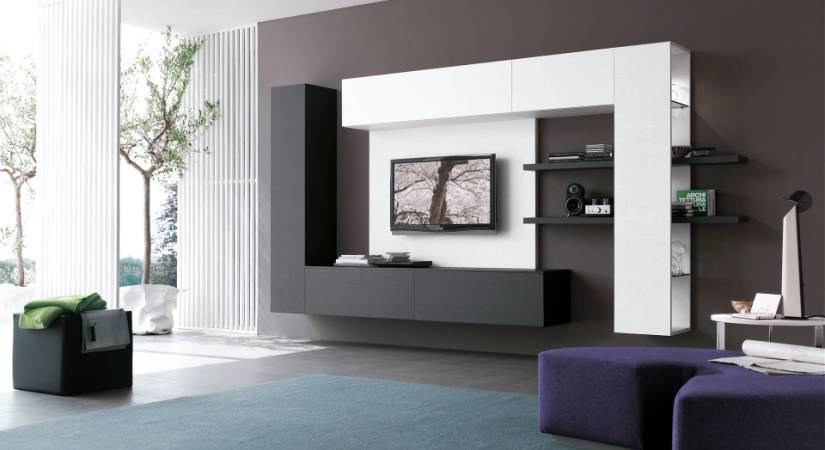
Welcome to our comprehensive post exploring a diverse array of Interior Architecture dissertation topics catered to students pursuing undergraduate, master’s, or doctoral levels of education. Embarking on a dissertation journey is a significant academic milestone, and choosing the right Interior Architecture dissertation topics can set the tone for a successful research endeavor.
In this post, we will delve into various captivating and relevant topics within the realm of Interior Architecture, providing invaluable insights and inspiration to ignite your academic pursuits in this field. Whether you are seeking to unravel the intricacies of spatial design, analyze the evolution of Interior Architecture, or explore sustainable design strategies, we’ve got you covered. Let’s navigate the exciting terrain of Interior Architecture dissertation topics together!
- Download Interior Architecture Dissertation Sample
A list of interior architecture dissertation topics:
Analyzing the integration of traditional craftsmanship and modern interior design: A case study of heritage preservation.
Investigating the influence of consumer behavior on interior architectural trends: A case study of changing preferences in the UK.
Analyzing the representation of cultural diversity in interior architecture: A comparative study of UK and global design practices.
Analyzing the use of biometric technologies in enhancing security and privacy in interior architectural designs.
Analyzing the role of lighting design in enhancing the dining experience in restaurants: A case study of fine dining establishments.
Exploring the influence of interior design on retail customer journey mapping: A case study of customer experience optimization.
Exploring the love for glass in interior architecture and design with a focus on spatial functionality.
Investigating the influence of interior design on learning environments: A case study of educational institutions.
Investigating the adoption of circular design principles in interior architecture: A sustainable approach to reduce waste and promote reuse.
Challenges faced by interior architecture and design students at different program levels in the UK- an investigation Link to Architectural design.
Does interior architecture affect patient responsiveness in the psychiatrist’s office?
Examining the impact of Brexit on the interior architecture industry in the UK: A post-transition analysis.
Analyzing the role of ergonomics in interior architecture: Designing for user comfort and efficiency in workspace environments.
The influence of sustainable design principles on urban residential spaces – A case study of eco-friendly materials in interior architecture.
Integrating inclusive design principles in healthcare facilities: Enhancing accessibility and usability for all users.
Does an academic certification from other disciplines help interior architecture students?
Exploring nature-inspired elements in modern interior architecture .
Evaluating the influence of interior design on academic performance and student engagement in educational institutions.
Analyzing the integration of artificial intelligence in interior architecture: Enhancing design efficiency and creativity.
Evaluating the influence of acoustics on interior spaces and user comfort in open office environments.
Exploring the integration of virtual reality technology in interior architecture: Enhancing user experience and design processes.
Interior architecture and design for educational spaces- what are the challenges for age, gender, and cultural variables?
A critical review of sustainable design practices in UK-based interior architecture firms: Challenges and opportunities.
Evaluating the impact of corporate governance on stakeholders’ firm valuation: A comparative review between developed and developing countries.
Investigating the impact of cultural globalization on interior architecture: Designing spaces for a diverse world.
How can interior architects adapt existing buildings for spatial functionality?
Analyzing the integration of soundscapes in interior architecture: Designing for auditory comfort and ambiance.
Analyzing the role of interior architecture in enhancing workplace diversity and inclusion: Designing for a multicultural workforce.
Investigating the role of sustainable transportation solutions in interior design: Designing for urban mobility and accessibility.
The role of interior architecture in promoting sustainability and environmental stewardship: A case study of LEED-certified buildings.
The play of light and color in public hospitals- is it possible to consider soothing impacts on all types of patients?
A comprehensive review of interior architecture trends in contemporary UK residential design.
What is the comparative use of technology by inexperienced and fresh interior architects as compared to experienced ones? A primary investigation.
Investigating the evolution of interior architecture education in the UK: A historical perspective and future outlook.
Analyzing the role of interior architecture in shaping healthy eating environments in commercial establishments.
Examining the role of corporate office design on employee productivity and well-being: A case study of major UK-based corporations.
Analyzing the integration of sustainability and luxury in high-end residential interior architecture: A case study approach.
A systematic review of interior architecture research methodologies: Trends and best practices.
Evaluating the integration of smart home technologies in enhancing accessibility for individuals with disabilities.
Analyzing the use of augmented reality in interior architecture: Enhancing visualization and user interaction.
The impact of smart home technology on contemporary residential interior design: A study of user preferences and adoption.
Investigating the influence of interior design on retail brand identity and customer loyalty: A case study of global fashion brands.
Examining the perception and use of public interior spaces in post-COVID-19 urban environments.
How has Hong Kong maintained its cultural origins and transformed itself through interior architecture?
Investigating the influence of sustainable design practices on consumer perceptions and preferences: A case study in the UK.
Investigating the influence of residential interior design on homeowners’ well-being and mental health.
Interior architecture for displaced settlements.
Investigating the use of recycled and upcycled materials in interior architecture: Designing sustainable and unique spaces.
Investigating the relationship between interior design and human psychology: A study on how design affects emotions and behaviors.
Investigating the role of interior architecture in creating therapeutic environments for individuals with autism spectrum disorders.
A review of interior architecture practices across heritage-rich countries.
How can exhibition spaces reflect design compatibility with spatial aesthetics- an exploration of the role of culture and context?
Investigating the role of lighting design in creating dynamic and engaging interior spaces for commercial retail environments.
Investigating the role of interior design in promoting social interactions and community cohesion in urban settings.
How important is the study of materials in interior architecture?
Examining the effectiveness of biophilic design in enhancing indoor air quality and well-being in residential interiors.
Investigating the resilience and adaptability of interior design businesses during and after the COVID-19 crisis.
Evaluating the impact of the COVID-19 pandemic on retail interior design: Adapting to changing consumer behaviors and preferences.
How are light pattern choices influential in the creation of relaxing public spaces?
Investigating the integration of universal design principles in interior architecture: Enhancing accessibility and inclusivity.
Evaluating the influence of interior design on consumer behavior in retail spaces: A case study of shopping malls.
Evaluating the impact of interior architecture on branding and consumer perception in the hospitality industry: A case study of luxury hotels.
How can interior architecture promote well-being in residential care units in the UK?
Stress and anxiety in interior architecture students- can creativity be taught?
Investigating the role of interior architecture in promoting physical activity and healthy living in residential spaces.
Playing with lights in interior architecture- consideration of choices and impacts.
Analyzing the use of unconventional materials in interior architecture: Designing with recycled and alternative resources.
Interior architecture for cinematic spaces- a literature review.
Analyzing the impact of historical preservation requirements on contemporary interior architecture in heritage buildings.
Analyzing the use of recycled and upcycled materials in interior architecture: Designing sustainable and unique spaces.
How have changing roles of domesticity altered demands on interior architecture and design?
Evaluating the influence of social media on interior design trends and consumer preferences: A case study of online platforms.
A primary study of current practices in interior architecture and design in the UK.
Evaluating the resilience and adaptability of interior design businesses during and after the COVID-19 crisis.
Investigating the use of virtual reality technology in interior architecture: Enhancing user
Investigating the perception and use of public interior spaces in post-COVID-19 urban environments.
Evaluating the effectiveness of experiential retail design in enhancing customer engagement and sales.
The impact of different interior architectures on human psychology- perspectives from literature.
Investigating the role of interior architecture in transforming underutilized urban spaces into vibrant community hubs.
Investigating the use of modular furniture in flexible workspace design: Enhancing adaptability and functionality.
Is it easier for interior architects to design commercial buildings or residential spaces? A primary study.
Evaluating the integration of renewable energy solutions in interior architecture: Designing sustainable energy-efficient buildings.
Investigating the role of interior architecture in promoting eco-tourism: Sustainable design for natural habitats.
The impact of color theory and psychology on interior design: A comparative analysis of different color schemes and their effects on space perception.
Analyzing the role of interior design in transforming retail spaces for e-commerce integration: A case study of brick-and-mortar stores.
Client preferences and interior architecture expertise in the UK- opposing factions or positive combinations?
Schools in glass buildings? An interior architects’ perspective.
Enhancing spatial functionality and aesthetics through innovative architectural design in interior spaces.
How can interior architects transform public spaces in emerging countries? A review.
Analyzing the role of interior design in reducing stress and anxiety in healthcare waiting rooms.
A comparative analysis of modular versus traditional construction methods in interior architectural projects.
Examining the influence of British design heritage on contemporary interior architecture: A case study of iconic design elements.
Evaluating the influence of cultural diversity on interior architecture trends in the UK: A comparative study of urban and rural areas.
Evaluating the role of lighting design in creating dynamic and engaging interior spaces for commercial retail environments.
Exploring the integration of smart home technology in interior architecture and its impact on domestic spaces.
The influence of material culture and heritage on interior architecture: A study of preservation and modern adaptation.
Interior architecture in times of personalized television- the scope and context of living rooms as family gathering spaces.
There you go. Use the list on interior architecture dissertation topics well and let us know if you have any comments or suggestions for our topics related blog posts for the future or looking to get help with dissertation writing , send us an email at [email protected] .
Paid Topic Consultation Service
You will get the topics first as per the given requirements, and then the brief which includes;
- An explanation why we choose this topic.
- 2-3 research questions.
- Key literature resources identification.
- Suitable methodology with identification of raw sample size, and data collection method
- View a sample of topic consultation service
Get expert dissertation writing help to achieve good grades
By placing an order with us, you can get;
- Writer consultation before payment to ensure your work is in safe hands.
- Free topic if you don't have one
- Draft submissions to check the quality of the work as per supervisor's feedback
- Free revisions
- Complete privacy
- Plagiarism Free work
- Guaranteed 2:1 (With help of your supervisor's feedback)
- 2 Instalments plan
- Special discounts
Related Posts
- 99 Modern Architecture Dissertation Topics | Research Ideas March 13, 2019 -->
- 99 Architectural Design Dissertation Topics | Research Ideas March 4, 2019 -->
WhatsApp us

Interior Design
- Articles & Journals
- Professional Development
- Literature Review
Article Databases for Interior Design
- Arts Premium Collection This link opens in a new window ProQuest Arts Premium Collection encompasses cross-searchable databases with thousands of journal titles, ensuring deep searches of extensive collections in Art, Design, Architecture, Humanities, Film/Screen Studies, Music, Performing Arts, and more. Consists of 9 databases: •ARTBibliographies Modern (ABM) •Design and Applied Arts Index (DAAI) •International Bibliography of Art (IBA) •Arts and Humanities Full Text (A&H FT) •American Film Institute Catalog (AFI) •FIAF Plus •Film Index International (FII) •International Index to Music Periodicals Full Text (IIMP FT) •International Index to Performing Arts Full Text (IIPA FT).
- Art & Architecture Complete This link opens in a new window Provides full text of 350+ journals and 200+ books dealing with art and architecture. Also indexes many other art and architecture publications and includes 60,000+ images.
- Design and Applied Arts Index This link opens in a new window This database is the premier source of information for all aspects of design and crafts, from textiles and ceramics to vehicle design, advertising and sustainability. Covers journal articles, exhibition reviews and news items from 1973 to the present.
- International Bibliography of Art This link opens in a new window The definitive resource for scholarly literature on Western art, IBA is the successor to the Bibliography of the History of Art (BHA), and retains the editorial policies which made BHA one of the most trusted and frequently consulted sources in the field. The database includes records created by the Getty Research Institute in 2008-09, with new records created by ProQuest using the same thesaurus and authority files.
- ARTBibliographies Modern This link opens in a new window This database is the only specialist bibliography available for the study of modern and contemporary art. Covers all art forms, including fine art, digital art, crafts, design and photography. Features full abstracts and indexing from art journals published from the late 1960s onwards. Also incorporates book records, including those drawn from the collections of the Tate Library and the Bibliothèque Dominique Bozo, Musée LAM.
- Applied Science & Technology Retrospective This link opens in a new window Contains historic (1912-1983) scholarly and popular articles related to engineering, construction management, architecture, chemistry, computer and information technology, geology, & physics. Linked full text only.
Interior Design Journals
A selection of journals available at Hunter Library. The list includes a mixture of peer-reviewed, trade, and popular titles.

- << Previous: Home
- Next: Books >>
- Last Updated: Nov 14, 2023 10:56 AM
- URL: https://researchguides.wcu.edu/interior-design
HUNTER LIBRARY
176 Central Drive Cullowhee, NC 28723 Administration: 828-227-7485 Reference: 828-227-7465 Circulation: 828-227-7485

QUICK LINKS
Ask-A-Librarian Reserve a Study Room My Account Library Catalog Article Databases Interlibrary Loan

- Interior Design
- Develop a Topic
Find Sources
- Search Effectively
- Evaluate Sources
- INTDSGN 1061 (Dooley)
- INTDSGN 1067 (Stafford)
- INTDSGN 3152 (Gulwadi)
- INTDSGN 4161 (Stafford)
Need Help with Citation?
- Guide to Citing Your Sources APA, MLA, Chicago and more!
- Scholarly Journals
- Standards and Code
- Associations
- Trade Publications
- White Papers

Scholarly journals contain peer-reviewed articles sharing original research by experts in their field. These research studies can include but are not limited to empirical or case studies and utilize qualitative or quantitative methods. Here are some examples of scholarly journals relevant to interior design research.
Find Scholarly Journal Articles
- Journal of Interior Design
- Journal of Facilities Management
- Design Issues
- Journal of Sociology
- Environment and Behavior
- Furniture History: the Journal of the Furniture History Society
- 2021 International Building Code International Code Council
- 2018 International Building Code International Code Council
- 2018 International Residential Code for One- and Two-Family Dwellings International Code Council
- 2017 ICC A117.1 Accessible and Usable Buildings and Facilities International Code Council
- International Interior Design Association The IIDA Knowledge Forum brings together web sources and forums to assist interior designers.
- American Association for Interior Designers The ASID Resource Center provides a variety of resources for interior designers from career development to project research.
Trade Publications are periodicals written by and for practitioners. You will find descriptions of projects and other useful information you can use to develop your designs. The articles in trade publications are not peer reviewed and may not contain rigorous research methods.
- Live Design
- Lighting Dimensions
- Walls and Ceilings
- Architectural Digest
- Healthcare Design Magazine
- IIDA Perspective
- Interiors+Sources
- Contract Design
- Hospitality Design
- Environments for Aging
- NEWH Hospitality Industry Network
White papers are reports providing authoritative information on a topic. They are designed to help readers understand a topic or set of issues quickly. They can be persuasive in nature and can lead readers to decisions, solutions, and even products or services. Companies may call these "resources" on their websites. They are extremely useful sources of information for interior design professionals.
- Herman Miller
- << Previous: Develop a Topic
- Next: Search Effectively >>
- Last Updated: Feb 7, 2024 10:34 AM
- URL: https://guides.lib.uni.edu/interior-design
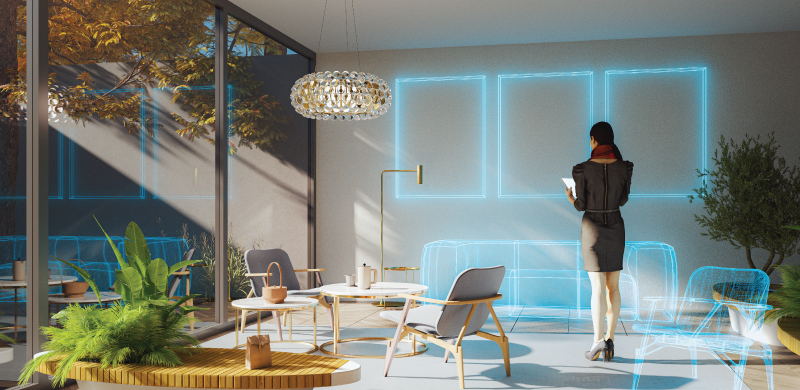
In our mission to support informed, sustainable, and healthy initiatives in the design of built spaces, the ASID Foundation provides funding to individuals and groups.
Below is a list of grants, scholarships, and prizes. Some grants are not open every year and amounts may vary from year to year. If a grant, scholarship, or prize is open there will be a link and information about the application deadline. The link will take you to information about the requirements, dates, and jury process. If there is not a link next to a grant, scholarship, or prize, then it is not currently open for application. You can also find links to past awardees and their projects to obtain a better understanding of the types of projects, qualifications of recipients, and level of outcomes and impact from those awardees. ASID, its members, and donors are proud that since 2012, the ASID Foundation has awarded over $1,000,000 through our programs.
General schedule of when applications are being accepted.
Transform Research Grant – Bi-annual Awards up to $100,000 Provides funding to address critical gaps in industry knowledge, advancing design understanding, and transforming the practice of interior design. Application period mid-April to mid-August 2024
Applied Research Grants – Multiple Awards at Various Amounts Funds research projects that result in actionable design principles, guidelines, and/or tools that designers can apply in their design projects. Application period mid-April to mid-August 2024
Irene Winifred Eno Grant - Award: $5,000 Provides financial assistance to individuals or groups developing an educational program or project dedicated to health, safety, and welfare. Application period mid-April to mid-August 2024
Poel Polsky Prize - Award: $5,000 Recognizes outstanding academic contributions to interior design through print or digital communication. Types of entries include books, whitepapers, blogs, videos, and more. Application period February 13, 2024 to April 22, 2024
Joel Polsky Academic Achievement Award - Award: $5,000 Recognizes an interior design research project or thesis project conducted by an undergraduate or graduate student related to wellness and design. Application period February 13, 2024 to April 22, 2024
Legacy Scholarship for Undergraduates - Award: $4,000 Open to all students in their junior or senior year of undergraduate study enrolled in at least a three-year accredited program of interior design. Application period February 13, 2024 to April 22, 2024
Legacy Scholarship for Graduate Students - Award: $4,000 Open to students who are enrolled in or accepted to a graduate-level interior design program at an accredited university. Application period February 13, 2024 to April 22, 2024
David Barrett Memorial Scholarship - Award: $12,000 Open to students who are enrolled in an undergraduate or graduate-level interior design program at an accredited university. Application period mid-February to mid-April 2025
Student Scholarships
The ASID Foundation manages the following scholarships which were established to expand research or to continue knowledge contributions in specific areas of design.
David Barrett Memorial Scholarship
Award: $12,000 Next Application Period: mid-February to mid-April 2025
The David Barrett Memorial Scholarship is given biennially to recognize the work of an outstanding undergraduate or graduate student who demonstrates a continuing interest and ability in utilizing classical designs (in alignment with Greek and Roman principals) and traditional materials, including furniture and fabrics.
Please be creative and innovative in how this is translated in your work. All project types will be accepted, including, but not limited to workplace, civic, residential, hospitality, and historical restoration.
Legacy Scholarship for Undergraduates Students
Award: $4,000 Next Application Period: February 13, 2024 to April 22, 2024
The Legacy Scholarship for Undergraduate Students is given annually to recognize academic accomplishment and creative achievement. This grant is open to all students in their junior or senior year of undergraduate study enrolled in at least a three-year accredited program of interior design. This grant is made possible by the generous support of the Dora Brahms Fund, Mabelle Wilhelmina Boldt Fund, Yale R. Burge Fund, Raymond Kennedy Fund, Ethel Siegelman Fund, and Alan Lucas Fund.
Application Requirements
- Design portfolio featuring 8-12 pages of work which demonstrates design solutions that positively impact occupant’s well-being.
- Portfolio statement (500 word maximum)
- Personal statement
- Transcript (an unofficial copy or alternate proof of enrollment will be accepted)
- Letter of Recommendation
- Biographical statement
Legacy Scholarship for Graduate Students
The Legacy Scholarship for Graduate Students is given annually to recognize the work of those students seeking to improve human outcomes and embracing and advancing the professional trend towards a more positive impact on user health and wellbeing. This grant is open to students who are enrolled in or have been accepted for admission to a graduate-level interior design program at an accredited university. This grant is made possible by the generous support of the Dora Brahms Fund, Mabelle Wilhelmina Boldt Fund, Yale R. Burge Fund, Raymond Kennedy Fund, Ethel Siegelman Fund, and Alan Lucas Fund.
- Personal Essay (1000 word maximum) The ASID Foundation believes that interior design positively transforms environments in ways that improve human outcomes. As an interior designer, how will you embrace and advance the professional trend to positively impact health and well-being in your anticipated area of design practice?
- Design portfolio (10 pages maximum)
VIEW PAST SCHOLARSHIP RECIPIENTS
Achievement Awards
Joel polsky academic achievement award.
Award: $5,000 Next Application Period: February 13, 2024 to April 22, 2024
Given annually, the Joel Polsky Academic Achievement Award recognizes an outstanding interior design research project or thesis project conducted by an undergraduate or graduate student related to wellness, educational research, behavioral science, business practice, design process, theory, or other technical subjects.
- Abstract (250 word maximum)
- Thesis, dissertation or research project
Gary Wheeler Professional Achievement Award
Award: $5,000 Next Application Period: mid-February to mid-April 2025
The Gary Wheeler scholarship is given annually to reimburse practitioners’ expenses for passing the NCIDQ. This grant is open to interior designers and educators who have recently passed all portions of the CIDQ exam. This award is made possible by the generous support of members.
Joel Polsky Prize
Given annually, the Joel Polsky Prize recognizes outstanding academic contributions to interior design through print or digital communication related to the needs of the public, designers, and students on topics such as, educational research, behavioral science, business practice, design process, theory, or other technical subjects. Types of entries can include, but are not limited to, books, whitepapers, blogs, and videos.
- Description of the publication or visual communication (250 word maximum)
- Copy of publication or visual communication
VIEW PAST AWARD RECIPIENTS
Research Grants
The ASID Foundation (ASIDF) Research Grant Program seeks to support research projects that result in actionable design principles, guidelines, and/or tools that designers can apply in their design projects.
Transform Grants | A – Seed/Start-Up Funds
Award amount varies: not to exceed $30,000 Next Application Period: mid-April to mid-August 2024
Transform Grant | B – Research Project
Award amount varies: not to exceed $70,000 Next Application Period: mid-April to mid-August 2024
The Transform Research Grants are made possible by the generous contribution of the Donghia Foundation. The grants are intended to provide funding to address critical gaps in industry knowledge, advance understanding, and transform the practice of interior design to improve the human experience.
Proposed research should be directly relevant, easily translatable, and of keen interest to both practicing designers and clients. Completed research projects are to be developed into an educational resource and shared with the design community.
The ASID Foundation Research Committee has noted the following scope of projects being considered for this period’s grants:
- Adaptive Environments Designed for Change and Resiliency
- Designing Humanizing Environments for Imperiled People
- Activating Diversity, Equity, and Inclusion in Design Solutions
Applied Research Grant (Previously Impact Research Grant)
Award amount varies Next Application Period: mid-April to mid-August 2024
Research Grants are given to support research projects that result in actionable design principles, guidelines, and/or tools that designers can apply in their design projects. This grant is open to any student, educator, interior design practitioner, institution, and interior design related group. This grant is made possible by the generous support of the ASID Foundation’s General Fund.
Irene Winifred Eno Grant
Award amount varies: not to exceed $5,000 Next Application Period: mid-April to mid-August 2024
The Irene Winifred Eno Grant provides financial assistance to individuals or groups developing an educational program(s) or project that is dedicated to health, safety, and welfare. This grant will be evaluated on the strength of the project proposal, budget, promotion plan, and expected outcome.
The grant is open to students, educators, interior design practitioners, institutions, and an interior design related group.
- Abstract (250 word maximum)
- Explanation of what the program/project will deliver and produce (500 word maximum)
- Explanation of how the program/project will be developed (500 word maximum)
- Explanation of how the program/project will be shared and promoted (500 word maximum)
- Proposed budget & timeline (Table format in Excel including key budget line items and cost in one sheet and key activities/milestones with target dates in one sheet)
- Primary Applicant’s Biographical Statement
- Primary Applicant’s Headshot
VIEW PAST RESEARCH GRANT RECIPIENTS
Interior Design Research Paper Topics
Angelique de la morreaux.

Interior design covers an array of topics, ranging from simple color theory to complex architectural design. These topics can be broken down further by variations through history, and the adaptations of design in different countries. Finding a topic for a research paper requires sifting through this abundance of information and limiting your paper to a very specific topic.
Explore this article
- Decorating Styles
- Color Combinations
- Architectural Differences
1 Decorating Styles
Interior design covers a vast array of decorating styles, including Art Deco, Edwardian, Victorian or Mission style. Describe the paint colors and trims used on the exterior of the house and the different types of wall treatments inside. Point out the architectural details that define the style, such as a tray ceilings, half-moon windows or tiny rooms. Discuss the elements of the furniture, the materials used in the construction of the furniture and the wood treatments or stains for a particular decorating style.
2 Color Combinations
Discuss color theory and the types of design choices within different color combinations. Explain the importance of the interplay of hard and soft surfaces as well as hues and tones in a monochromatic design scheme. Give an example of the harmonious color scheme, which consists of three colors next to each other, or a complementary scheme which involves opposite colors on the color wheel. Showcase the advantages of a neutral palette or the addition of a neutral into a colorful design.
3 Architectural Differences
Concentrate your paper on comparing and contrasting the architectural details within one style over different regions and countries. Several architectural styles to choose from include Gothic, Greek Revival, Rococo or Tudor. Compare the similiarities with the styles, such as the use of straight, curved or elaborate lines, the placement of the rooms within the house, and the types of lighting or window frames used in the design. Showcase the differences between the regions as you point out the types of furniture, transition of color or style in the material and fabrics used.
As the interior design field is constantly evolving, write your paper about new trends in design. Discuss the transition period for architecture and furniture as it bridges the gap between the old and new trends. Explain the color choices, fabrics and prints for the new season and how they are chosen. Showcase the new accessories, lighting details, paint treatments, wall colors or wall paper designs that are becoming hot. Point out any of the older trends which will be remaining with the new ones.
- 1 Better Homes & Gardens: ShareThis Decorating Styles & Decor
- 2 Color Matters: Color Theory
About the Author
Angelique de la Morreaux began writing articles for various websites in 2010. Her focus is in the legal, small business, beauty, holiday, culture, food, drinks and automotive categories. Morreaux holds a Bachelor of Arts in social sciences from San Diego State University.
Related Articles

The Difference Between Baroque, Romantic & Gothic Churches


How to Make a Shoebox House School Project

A Sandblasted Headstone vs. an Etched Headstone

How to Build Wigwams for a School Project

How to Make Fragments & Fireworks on GIMP

Facts About Clothes in Ancient China

What Kinds of Boots to Wear With Dresses for Summer

How to Tie-Dye Converse

What Nail Polishes Go With a Green Dress?

Types of Architecture Courses

Characteristics of Islamic Architecture

How to Decorate Lattice for Weddings

Types of Obscure Glass

The Use of Light in Islamic Architecture

Traditional Designs of Lutheran Churches

How to Decorate a Church Interior

Can Petite Women Wear Maxi Dresses?

Types of Windows for Churches

What Is Imperial Jade?

Drop Waist vs. Natural Waist
Regardless of how old we are, we never stop learning. Classroom is the educational resource for people of all ages. Whether you’re studying times tables or applying to college, Classroom has the answers.
- Accessibility
- Terms of Use
- Privacy Policy
- Copyright Policy
- Manage Preferences
© 2020 Leaf Group Ltd. / Leaf Group Media, All Rights Reserved. Based on the Word Net lexical database for the English Language. See disclaimer .
- Bibliography
- More Referencing guides Blog Automated transliteration Relevant bibliographies by topics
- Automated transliteration
- Relevant bibliographies by topics
- Referencing guides
20 Thesis topics related to Residential Design

A residence is one of the first projects any architecture student is asked to design as part of the curriculum , as a residence is one of the first examples of architecture we all see and so many of us are fortunate to live in. Residential projects may seem very easy to comprehend and design, but the various types of residences that are in use today and the different user groups they are targeted towards make it a vast topic, something that requires huge amounts of research to design.
Choosing a residential project as a thesis topic in the final year of B.Arch. would be like coming full circle – applying all the knowledge you have gained in the last five years on the very first project typology you were taught to design.
So, here are 20 thesis topics related to residential typology that any architecture student can take up.
1. Mixed-Use Buildings | Residential Design
With the global pandemic forcing people to stay confined in their houses, the development of mixed-use buildings with residential, commercial and office spaces all in one place will help with similar circumstances in the future. A student would need to do extensive research on how to properly combine all different places and the purposes they serve to create a building that fulfils functionality and is also aesthetically pleasing.
Mixed-use buildings as a thesis topic will help a student when they start working because of its huge potential as a future trend in architecture.

2. Vertical Housing
With the increasing population and declining availability of open land, vertical housing is one of the best solutions available to tackle the requirements of the current and future generations. Vertical housing is residential buildings where architects arrange spaces vertically instead of horizontally, to create more units in a smaller footprint.
These buildings also contain community areas and green spaces interspersed with the residential units to encourage people to be more social and not stay confined in their high-rise apartments .
Using this as a thesis topic will be extremely beneficial as there are high chances of designing similar projects when students start professionally practising after getting their degrees.

3. Community living | Residential Design
One of the first markers of human beings settling down and becoming civilized is when they started living in communities with individual houses and common spaces for gathering. Since then, human beings have always preferred to live in a society.
Be it apartment complexes with high-rise buildings , or housing estates with horizontal, community living in urban areas are a topic that can be taken up as a thesis project related to residential use. Community living will help one understand how to design spaces that can be used by different people to live together in harmony.

4. Row Houses
Row houses are defined as a series of houses connected through common sidewalls. They are a great way to build individual houses in smaller areas and with lesser materials, making them cheaper.
Row houses might already be in use in the USA and European countries , but they have huge potential in third-world countries and in places like India where there is a space crunch issue, making them a good thesis topic under the residential typology.

5. Tiny Houses | Residential Design
These are houses that have a total area of less than 400 ft 2 or 37 m 2 and are a good alternative to traditional houses when the available open land is smaller than average. Tiny houses have a wide variety of design considerations and this leads to innovative spaces that are multifunctional and furniture that is multi-purpose.
Compacting a whole house in an area that is less than 400 ft 2 is a challenge that will help thesis students in designing residential areas in the future, as the availability of free land is reducing every day.

6. Shipping Container Homes
20 ft or 40 ft steel containers that have been used to carry different types of goods in ships can be used as a readymade or prefabricated skeleton to build a house. These homes are a good way to re-purpose shipping containers that have been abandoned or thrown away and are easier and faster to build as the exterior structure is already available.
The containers can be stacked vertically or horizontally to create everything from tiny houses to mansions. Shipping container homes are an intriguing and unique residential thesis topic for students.

Yurts are portable houses consisting of a latticework of wood or bamboo covered by a round tent and have been the traditional houses for many tribes in central Asia, especially in Mongolia. Yurts are a unique aspect of vernacular architecture that can be adapted in different climates around the world with the use of more modern materials like steel for the latticework and insulating fabrics for the tent.
Yurts as a residential thesis topic will give students a different look in a sustainable and vernacular approach to designing.

8. Earthships | Residential Design
Pioneered by architect Michael Reynolds, Earthships are a type of passive solar earth shelter that is built with both natural and up-cycled materials. These residential units are structures built on the principle that the six human needs of energy, garbage management, sewage treatment, shelter, clean water and food can be met through environmentally sustainable building design.
Earthships are intended to be simple, “off-the-grid” homes with minimal dependence on fossil fuels and public utilities and can be constructed by people with little building knowledge. The scope of Earthships as self-sustainable and ecological single-family residences is huge and something that can be taken up by architecture students for their final year thesis.

9. Cob Houses
These are houses built of clay, sand and straw that are recyclable and non-polluting when demolished. Cob houses are inexpensive, energy-efficient houses suitable for hot climates that are also extremely durable and earthquake-resistant.
Even though these types of houses have traditionally been user-built, an architect’s perspective will help in enhancing its ecological and sustainable features and lead to better planning and usability of spaces. Cob houses should be explored as a thesis topic in the residential typology.

10. Cave houses | Residential Design
Caves served as the very first human dwellings – they served as a shelter against natural calamities and wild animals. In recent years, cave dwellings have made a comeback, in the form of carving contemporary houses inside existing caves. These houses contain contemporary elements like doors and windows, modern electrical and bathroom fittings and also connections to public utilities and “off-the-grid” options for the same.
Designing cave houses is a challenge because one has to carve out different rooms in accordance with the inside of the cave and major changes cannot be done to the structure of the cave. Cave houses provide the option to utilize existing natural shelter formations instead of disrupting green areas, and hence are a good residential topic for the thesis as they are becoming more popular.

Ipshita Seth has been in love with words for as long she can remember and now that she's studying Architecture, she's found a new love for writing about designing spaces, history of buildings, construction technologies and everything else that comes with them. She has joined RTF to give words to her dreams.

How is LGBT Community help build gender inclusive architecture

15 Books related to Light in Architecture that every architect must read
Related posts.

Timeline of restoration: Mont Saint-Michel

An inquiry into the intersection of culture and sustainability in tourism

How can architecture be used to create more sustainable and resilient communities?

Transforming Indian Streets: Embracing Storm Water Management

The Healing Power of Built Environments: A Journey through Restorative Architecture

Elevating Journeys: The Impact of Airport Architecture on Passenger Experience
- Architectural Community
- Architectural Facts
- RTF Architectural Reviews
- Architectural styles
- City and Architecture
- Fun & Architecture
- History of Architecture
- Design Studio Portfolios
- Designing for typologies
- RTF Design Inspiration
- Architecture News
- Career Advice
- Case Studies
- Construction & Materials
- Covid and Architecture
- Interior Design
- Know Your Architects
- Landscape Architecture
- Materials & Construction
- Product Design
- RTF Fresh Perspectives
- Sustainable Architecture
- Top Architects
- Travel and Architecture
- Rethinking The Future Awards 2022
- RTF Awards 2021 | Results
- GADA 2021 | Results
- RTF Awards 2020 | Results
- ACD Awards 2020 | Results
- GADA 2019 | Results
- ACD Awards 2018 | Results
- GADA 2018 | Results
- RTF Awards 2017 | Results
- RTF Sustainability Awards 2017 | Results
- RTF Sustainability Awards 2016 | Results
- RTF Sustainability Awards 2015 | Results
- RTF Awards 2014 | Results
- RTF Architectural Visualization Competition 2020 – Results
- Architectural Photography Competition 2020 – Results
- Designer’s Days of Quarantine Contest – Results
- Urban Sketching Competition May 2020 – Results
- RTF Essay Writing Competition April 2020 – Results
- Architectural Photography Competition 2019 – Finalists
- The Ultimate Thesis Guide
- Introduction to Landscape Architecture
- Perfect Guide to Architecting Your Career
- How to Design Architecture Portfolio
- How to Design Streets
- Introduction to Urban Design
- Introduction to Product Design
- Complete Guide to Dissertation Writing
- Introduction to Skyscraper Design
- Educational
- Hospitality
- Institutional
- Office Buildings
- Public Building
- Residential
- Sports & Recreation
- Temporary Structure
- Commercial Interior Design
- Corporate Interior Design
- Healthcare Interior Design
- Hospitality Interior Design
- Residential Interior Design
- Sustainability
- Transportation
- Urban Design
- Host your Course with RTF
- Architectural Writing Training Programme | WFH
- Editorial Internship | In-office
- Graphic Design Internship
- Research Internship | WFH
- Research Internship | New Delhi
- RTF | About RTF
- Submit Your Story
Looking for Job/ Internship?
Rtf will connect you with right design studios.

- Hispanoamérica
- Work at ArchDaily
- Terms of Use
- Privacy Policy
- Cookie Policy
10 Interior Design Trends of 2021

- Written by Hana Abdel & Dima Stouhi
- Published on December 15, 2021
As 2021 comes to an end, we look back at how this year introduced new normals and raised questions about what the future of the built environment could look like. In retrospect, not much has changed in regards to where people are spending most of their time. Following constant changes in commuting restrictions and the continuation of the pandemic, people acknowledged that most of their time will be spent indoors, so they adapted their living and working spaces accordingly.
These sudden lifestyle changes forced people to become well aware of the fact that the space they inhabit has great influence on their physical and mental wellbeing, so they began opting for features that promote sensitivity, calmness, optimism, and playfulness, emotions that counter the inconsistent and troublesome events taking place in the outside world and offer an implied sense of escapism.

Some trends and features that were prominent in 2020 , such as biophilic designs , use of local materials , and muted hues, stood their ground in 2021. Others were newly introduced and heavily utilized in projects of diverse scales and functions. 2021 also saw more design diversity in commercial and retail interiors compared to residential projects, highlighting how architects, designers, and business owners found different ways to translate their concepts into visual and physical narratives.
Read on to discover 10 design trends that shaped the interior spaces of 2021.
Biophilic Interiors and Bringing Nature In

Lighting as a Feature Element

Exterior Cladding Used as Interior Finishes

Raw and Unfinished Concrete Interiors

The Kaleidoscope Effect: Vibrant Colors and Reflective Surfaces

Curves and Free-flowing Forms

Boxed In: Volumes within Volumes

Pastels and Muted Hues

Straight-out-of-Comic-Books Interiors

Flexible and Transformative Interiors

This article is part of the ArchDaily Topic: Year in Review . Every month we explore a topic in-depth through articles, interviews, news, and projects. Learn more about our monthly topics . As always, at ArchDaily we welcome the contributions of our readers; if you want to submit an article or project, contact us .
Image gallery

- Sustainability
想阅读文章的中文版本吗?

2021年十大室内设计趋势
You've started following your first account, did you know.
You'll now receive updates based on what you follow! Personalize your stream and start following your favorite authors, offices and users.
Design & Make with Autodesk
- Architecture, Engineering, Construction & Operations
- Product Design & Manufacturing
- Media & Entertainment
- Emerging Tech
- Point of View
Generative Design
Quickly generate high-performing design alternatives—many that you’d never think of on your own—from a single idea. With generative design, there is no single solution; instead, there are multiple great solutions. You choose the design that best fits your needs.

What is generative design?
Generative design is a design exploration process. Designers or engineers input design goals into the generative design software, along with parameters such as performance or spatial requirements, materials, manufacturing methods, and cost constraints. The software explores all the possible permutations of a solution, quickly generating design alternatives. It tests and learns from each iteration what works and what doesn’t.
Generative design by industry

Generative Design for Product Design and Manufacturing
Helps you explore more CAD-ready design options that are optimized for cost, material, and production method.
Image courtesy of Briggs Automotive Company
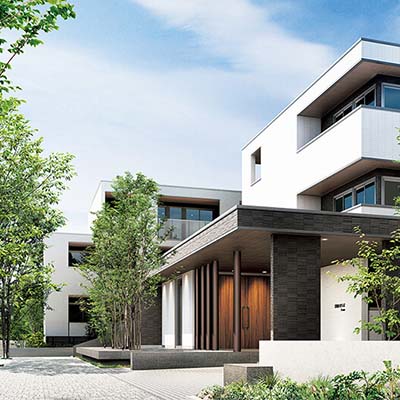
Generative Design for Architecture, Engineering & Construction
Helps you explore solutions by rapidly testing, analyzing, and evaluating iterations for building design challenges.
Benefits of generative design
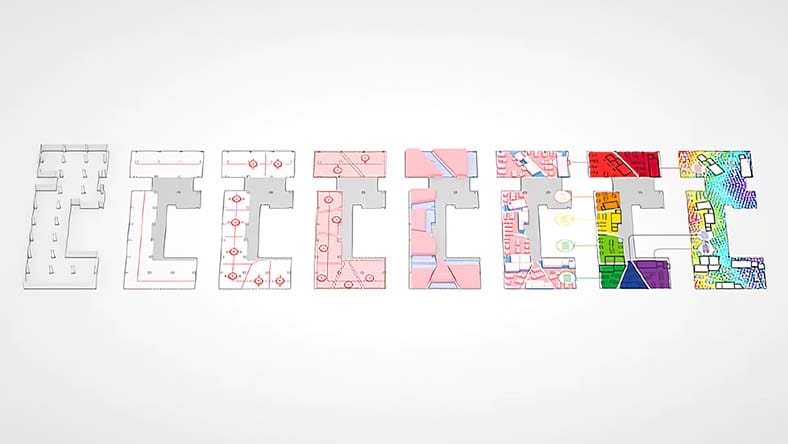
Explore a wider range of design options
In the time you can create one idea, a computer can generate thousands, along with the data to prove which designs perform best.
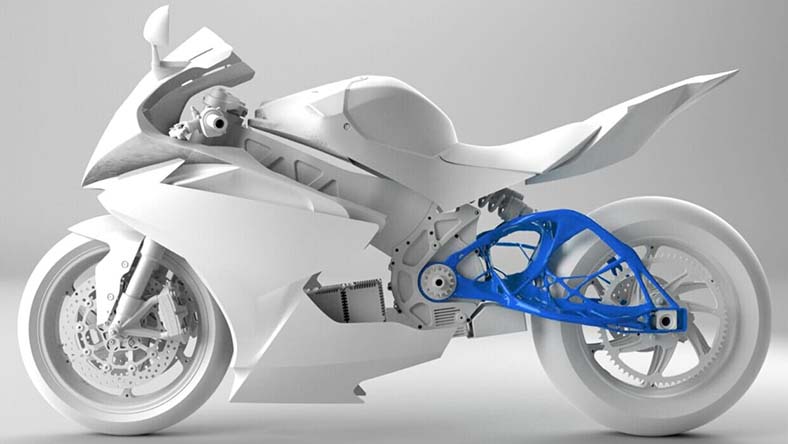
Make impossible designs possible
Generative design lets you create optimized complex shapes and internal lattices. Some of these forms are impossible to make with traditional manufacturing methods. Instead, they're built using new additive manufacturing methods.
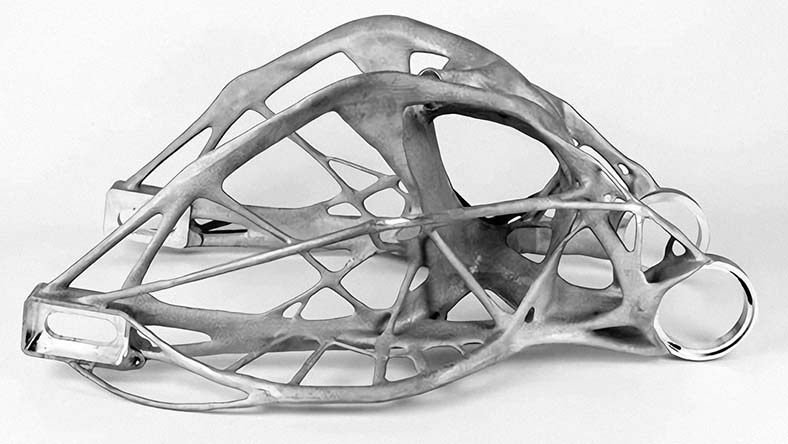
Optimize for materials and manufacturing methods
Set goals and parameters, and the software will create high-performing design options based on those constraints. The software resolves conflicting design constraints so you can focus on innovating.
From aerospace to architecture and construction
Generative design is out of the lab and being used in the field. Learn how the world's most innovative companies are using this technology today.
From light-weighting components to parts consolidation, Autodesk generative design is being used by companies shaping the future of the automotive industry.
With design and manufacturing goals around weight reduction, environmental impact, and safety, the aerospace industry is adopting generative design to explore new design options and improve performance.
Consumer goods
The ability to simultaneously generate multiple CAD-ready, process-aware solutions to a design problem has a positive impact on innovation and productivity.
Architecture and construction
As demonstrated with the layout and design of the Autodesk Toronto office, generative design technology can help you explore solutions for goals and constraints outside of manufacturing.
Industrial machinery
Manufacturers of specialty tools and equipment are proving that Autodesk generative design can help them break innovation barriers.
Building products
Industrial building products suppliers are proving complex assemblies can be simplified with the help of generative design and additive manufacturing.
Generative design customer stories

Driving mobility innovation
The Hyundai Motor Group is pushing the boundaries of vehicle development and reimagining how vehicles might traverse the world with the help of generative design.

Discovering new impact with generative design
Edera Safety uses Fusion 360 to design, prototype, and begin manufacturing an innovative flight mask to help keep service workers safer and healthier during the COVID pandemic.

Mainstreaming sustainability
MG AEC used generative design for proof-of-concept that high-performance building design can, and in the face of climate crisis, must , become mainstream.
Related manufacturing technologies
Autodesk has software to cover all your design for manufacturing needs. Learn about some of the other innovative technology we produce.
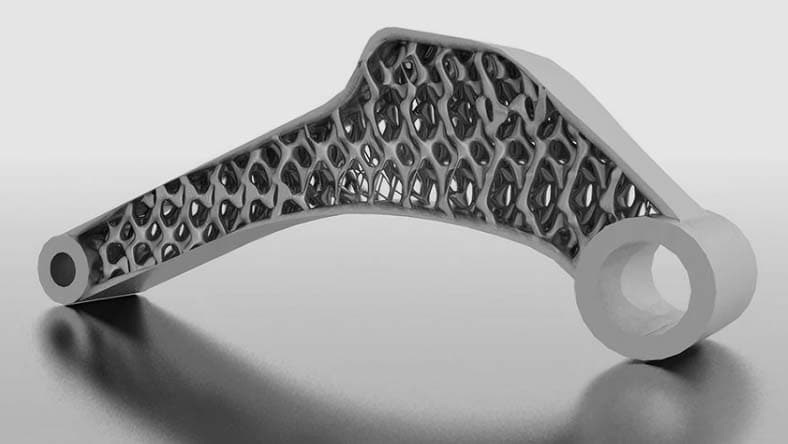
Internal lattice structures
Create lightweight parts with performance characteristics specific to your application.
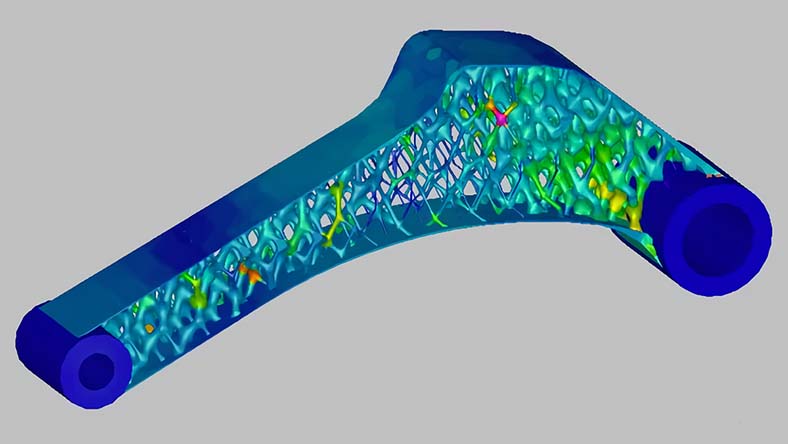
Topology optimization
Generate forms that are optimized for stiffness and weight, based on the loads and constraints of the part.

Trabecular structures
Precisely scale and distribute tiny pores through solid materials, creating surface roughness to mimic bone in medical implants to help patients heal.
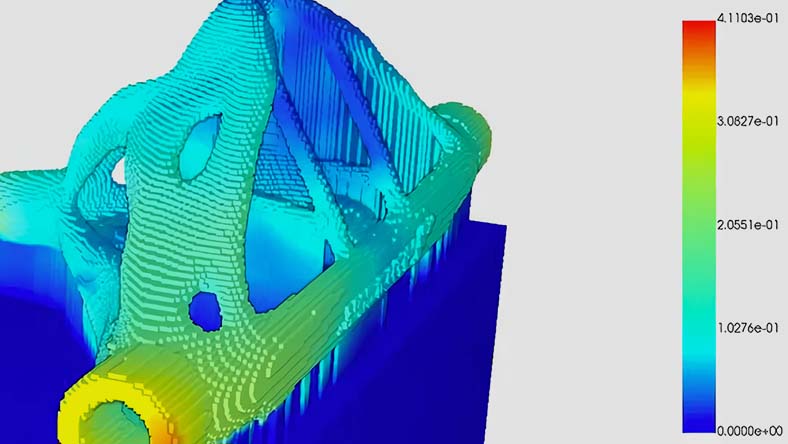
Complex part simulation
Apply thermomechanical modeling to large geometries designed for additive manufacturing.
Privacy | Do not sell or share my personal information | Cookie preferences | Report noncompliance | Terms of use | Legal | © 2024 Autodesk Inc. All rights reserved

IMAGES
VIDEO
COMMENTS
A List Of Potential Research Topics In Interior Design. Repurposing shipping containers: innovative design approaches for affordable housing. Resilient interior spaces: adapting homes and commercial interiors for future crises and disturbances. Urban farming integration in residential interior design: sustainable living.
Past Thesis Titles. All M.F.A. students in Interior Architecture complete theses. Theses cover a wide range of topics within interior architecture and reflect the variety of student research interests. The thesis topic is developed by the student in concert with her/ his faculty in the first year of study.
The Journal's publications investigate the interior relative to design, human perception, behavior, and experience, at all scales and for all conditions. Scholarship published in the Journal shapes, informs, and defines interior design education, practice, research, criticism, and theory. View full journal description
The ASID 2023 State of Interior Design Report provides an overview of the current state of interior design broken into three segments focusing on People, Firms, and Services. The state of the interior design industry is robust, and the industry saw the creation of more than 1,000 new interior design firms and 4,500 jobs in 2022. Download the ...
Explore the latest full-text research PDFs, articles, conference papers, preprints and more on INTERIOR DESIGN. Find methods information, sources, references or conduct a literature review on ...
Scholarship published in the Journal shapes, informs, and defines interior design education, practice, research, criticism, and theory. (Revised February 2021) ... In this case, the article includes a contextual statement that introduces the design, the research topic, and the perspective. Rather than rely on the authority of textual language ...
The Resource Center is an online repository of information on the latest interior design research, hot topics, and current trends. Filter by topic, career stage, and more to find the resources most relevant to your needs. The American Society of Interior Designers (ASID) advances the interior design profession and communicates the impact of ...
The journal focuses on studying the interior of design, human perception, behavior, and experiences, covering all scales and conditions. The research published in the journal influences interior design education, practice, research, criticism, and theory. Members of IDEC can access the journal as a membership benefit.
Vaux, D. E., & Wang, D. (2021). Research methods for interior design applying interiority. New York and London: Routledge. ISBN 978--367-13949- (paperback). 369 pages. Research Methods for Interior Design Applying Interiority edited by Dana E. Vaux ... precision of a research topic, while the methods section notes the need for data ...
Research Methods for Interior Design provides a broad range of qualitative and quantitative examples, each highlighted as a case of interior design research. Each chapter is supplemented with an in-depth introduction, additional questions, suggested exercises, and additional research references. The book's subtitle, Applying Interiority ...
Perspective. Two perspectives are now available for your reading in Early View: " Interior Design: Living in Poverty and the Absence of Health, Safety, and Welfare" by Shelby S. Hicks and " Hybrid Workplace: Activity-based Office Design in a Post-Pandemic Era" by Işıl Oygür, Özgür Göçer, and Ebru Ergöz Karahan. These invited pieces illustrate the pluralistic approach to ...
Basic Research Methods and Techniques in interior design: 1-Subjective technique vs. Objective can be based on assessment and communication methods like: Questionnaires, Interviews, Focus groups*, etc. The subjective* techniques assess feelings, thought s, perceptions, attitude and state of mind.
Find the latest published documents for interior design, Related hot topics, top authors, the most cited documents, and related journals. ... These boards are used in the field of interior design, especially. The aim of this research was to evaluate the effect of variable environmental conditions on the physical and mechanical properties of ...
A list of interior architecture dissertation topics: Analyzing the integration of traditional craftsmanship and modern interior design: A case study of heritage preservation. Investigating the influence of consumer behavior on interior architectural trends: A case study of changing preferences in the UK. Analyzing the representation of cultural ...
The Journal of Interior Design is a scholarly, refereed publication dedicated to issues related to the design of the interior environment. The library has 1997-present online. Architectural Digest. The international magazine of fine interior design. The library has 1969-1985 in print and 2008-present online.
Interior design practice is generally defined to encompass a wealth of practical knowledge that covers problem solving, technical and aesthetic aspects to create its artefact Haddad, 2014 ...
White Papers. Scholarly journals contain peer-reviewed articles sharing original research by experts in their field. These research studies can include but are not limited to empirical or case studies and utilize qualitative or quantitative methods. Here are some examples of scholarly journals relevant to interior design research.
Select the topic you are interested in and are ready to devote hours to the research and analysis of the information. Give preference to creative paper writing ideas that will help you to stand out. Keep all of the points in mind when selecting among topics. Here are 25 interior design topic ideas for you to get inspired.
Recognizes an interior design research project or thesis project conducted by an undergraduate or graduate student related to wellness and design. ... and students on topics such as, educational research, behavioral science, business practice, design process, theory, or other technical subjects. Types of entries can include, but are not limited ...
Interior design covers an array of topics, ranging from simple color theory to complex architectural design. These topics can be broken down further by variations through history, and the adaptations of design in different countries. Finding a topic for a research paper requires sifting through this abundance of ...
This research focuses on four main topics: Children's' Cognitive Development as it relates to age-appropriate interior design; Children's Hospital Design and healing environments; Public Spaces in Hospitals - interior architecture and interior design; Contextual Issues - specifically, the religious, ethnic and national context of Palestine.
Yurts as a residential thesis topic will give students a different look in a sustainable and vernacular approach to designing. 8. Earthships | Residential Design. Pioneered by architect Michael Reynolds, Earthships are a type of passive solar earth shelter that is built with both natural and up-cycled materials.
News Articles Design Trends Cladding Design Decor Biophilia Interior Design ArchDaily Topic 2021 Year in Review Horenychi Architecture Cite: Hana Abdel & Dima Stouhi. "10 Interior Design Trends of ...
"This research project is exactly what we want our faculty to be doing as a land-grant institution. It will use cutting-edge technology to address real-world problems in collaboration with one of the top 10 architecture and design firms in the nation," said Carl Matthews, professor and head of the Department of Interior Architecture and Design.
Designers or engineers input design goals into the generative design software, along with parameters such as performance or spatial requirements, materials, manufacturing methods, and cost constraints. The software explores all the possible permutations of a solution, quickly generating design alternatives.